

Monday, September 2, 2002
![]()
Lapping Waves
Night sounds on a small mangrove island are different from
those in the middle of a tropical jungle—whether one is sleeping on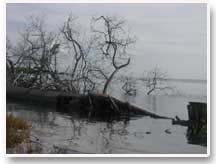 a boat in the middle of the Amazon River or in a thatched hut somewhere
in Ghana. There are no tree hyrax screaming at midnight and no howler monkeys
announcing that dawn is approaching with a sound that makes it seem as though
Godzilla will arrive at any moment. Mostly though, what is absent here is
the constant din of millions of insects. Instead, on most
a boat in the middle of the Amazon River or in a thatched hut somewhere
in Ghana. There are no tree hyrax screaming at midnight and no howler monkeys
announcing that dawn is approaching with a sound that makes it seem as though
Godzilla will arrive at any moment. Mostly though, what is absent here is
the constant din of millions of insects. Instead, on most 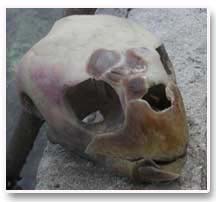 nights,
there is only the sound of the waves rhythmically lapping against the shoreline
and sometimes the sound of rain on the metal roof. Nothing more.
nights,
there is only the sound of the waves rhythmically lapping against the shoreline
and sometimes the sound of rain on the metal roof. Nothing more.
Last night, however, was a sleepless night for most of us. A storm rolled
in around 10:00 PM and lasted for most of the night. It was ferocious—with
wind, thunder, and lightening. We seemed to be at the center of the action.
At one point a bolt of lightening stuck too close to the dorm for comfort.
The dorm lit up completely with light and shook with the simultaneous clap
of thunder. Worried that our wet suits hanging to dry might blow away, Shelly
went outside to retrieve them. Terin had to get up and lock the door at
another point as a terrified Sultan, the male dog, tried to sneak in to
get out of the storm. Finally at dawn the storm subsided into a light rain
that continued throughout the morning.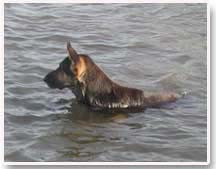 During
the day, both dogs spent the day chasing mullet fish in the back bay.
During
the day, both dogs spent the day chasing mullet fish in the back bay.
Crumbling Sea Walls
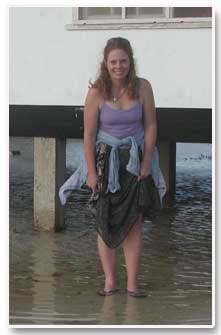 Spanish
Bay Research Station sits on one end of a very small caye and is largely
composed of landfill. The sea wall around this end is in a state of disrepair
and is continually reinforced in places by new fill—like old tires
and even old car batteries. Long tree branch stakes are also used to support
the cracking concrete. It is a constant battle to keep the artificial dry
land on the caye from washing into the sea. Eventually, the land will lose
and the sea will reclaim what naturally belongs to it. On these cayes, everything
is in a state of change.
Spanish
Bay Research Station sits on one end of a very small caye and is largely
composed of landfill. The sea wall around this end is in a state of disrepair
and is continually reinforced in places by new fill—like old tires
and even old car batteries. Long tree branch stakes are also used to support
the cracking concrete. It is a constant battle to keep the artificial dry
land on the caye from washing into the sea. Eventually, the land will lose
and the sea will reclaim what naturally belongs to it. On these cayes, everything
is in a state of change.
The ground is never really dry here no matter what. At high tide the sea
disregards the seawall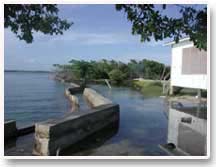 and floods the area behind and underneath the dormitory. Walking out across
the ground anywhere sends the hundreds of fiddler crabs racing for the safety
of their homes in the ground. Today the tide was higher than anything we
have yet to see, flooding almost all of our walking areas with three inches
of water. During these floods, the animals that normally live on the other
side of the seawall find their way to ours. A blue crab was spotted scurrying
to the dormitory. Another time an octopus took a similar tour.
and floods the area behind and underneath the dormitory. Walking out across
the ground anywhere sends the hundreds of fiddler crabs racing for the safety
of their homes in the ground. Today the tide was higher than anything we
have yet to see, flooding almost all of our walking areas with three inches
of water. During these floods, the animals that normally live on the other
side of the seawall find their way to ours. A blue crab was spotted scurrying
to the dormitory. Another time an octopus took a similar tour.
The Weekend
We spent Saturday learning how to process
seagrass samples. It is a long and tedious process. The entire sample
must be separated into five different categories, each category weighed,
dried in a special oven, and then weighed again. Katie takes these dried
samples back home for further study.
Sunday we spent collecting more seagrass samples from two different areas.
It was a little more challenging than the other day—it rained almost
constantly while we were out and there was a bit of a current. At one point,
Shelly, Kevin, and Krisan lost sight of “The Beast”, the device
that we use to extract seagrass samples from the sea floor. The sea floor
was so churned up that after they placed it they couldn’t see it. Fortunately,
after some diving, they did!
We have begun to post descriptions of the data collection methods we are
using along with data on the Daily
Data page. Be sure to read about “The
Beast.”
Stinging Cells
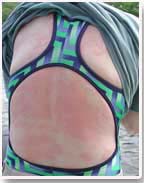 One
of the things we try hard not to do when snorkeling is to stir up the bottom
of the sea floor with our flippers. This is a challenge because often times
we are not in very deep water. When the bottom mud gets stirred up it becomes
very difficult to see what we are doing. Sometimes the stirred mud clouds
One
of the things we try hard not to do when snorkeling is to stir up the bottom
of the sea floor with our flippers. This is a challenge because often times
we are not in very deep water. When the bottom mud gets stirred up it becomes
very difficult to see what we are doing. Sometimes the stirred mud clouds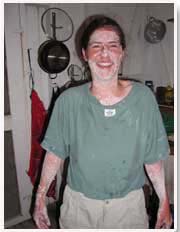 contain floating stinging cells that feel like hundreds of needles pricking
your exposed skin. There is a bottle of vinegar on the boat that we pour
on the affected areas to ease the stinging when this happens. Most of us
had a vinegar bath once we got back on the boat on Sunday.
contain floating stinging cells that feel like hundreds of needles pricking
your exposed skin. There is a bottle of vinegar on the boat that we pour
on the affected areas to ease the stinging when this happens. Most of us
had a vinegar bath once we got back on the boat on Sunday.
Today, while in the water Katie had a reaction to something
she swam through. The reaction began on her arm and soon spread to her entire
body. When she got back to camp she bathed herself in baking soda. Fortunately
Katie has a good sense of humor and doesn’t complain much.
Because it was raining this morning Katie and Caryn decided it would be
a good time to have our manatee lecture. It was okay by us as we weren’t
real eager to spend another day out in the water in the rain. Caryn gave
us a description of the evolution of manatees and dugongs as well as information
about their habitats. She also explained the current research that is being
done around the world on them. We asked so many questions that the lecture
ran over. We will do part two and three another day.
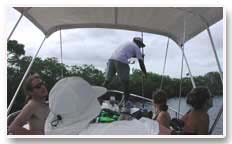 Around
11:00 AM the clouds began to lift and the sun appeared. Half the team went
out on the boat to gather more data and the other half stayed back to process
the seagrass
Around
11:00 AM the clouds began to lift and the sun appeared. Half the team went
out on the boat to gather more data and the other half stayed back to process
the seagrass samples that we had collected over the weekend. At one point we took a break
from processing seagrass and Caryn showed us a turtle head she found. She
was keeping it in a bag over the side so that it would finish decaying.
You could still see some of its flesh.
samples that we had collected over the weekend. At one point we took a break
from processing seagrass and Caryn showed us a turtle head she found. She
was keeping it in a bag over the side so that it would finish decaying.
You could still see some of its flesh.
There were two sightings of manatees today from the boat and Krisan spotted
both of them first! The team took more seagrass samples that we will process
tomorrow (ugh!) On their way back they stopped to pick up trash that they
found floating.
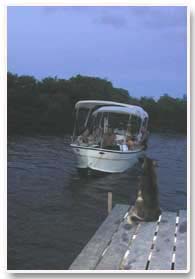 The
boat returned late. It was already twilight and, as always, Sultan and Nina
were there waiting.
The
boat returned late. It was already twilight and, as always, Sultan and Nina
were there waiting.
Lobster Dinner
After six days here in extremely close quarters, the 12 of us are getting
along amazingly well. Everyone is flexible, good natured, and willing to
assist with anything that needs doing. We really are a team. Ernest, Pam, and Katie only have one more day here before they
leave for home. We are going to be very sad to see them go. More, since
Pam may be the only one who truly understands how to record data on the
multitude of data sheets, we are going to be sunk without her.
are a team. Ernest, Pam, and Katie only have one more day here before they
leave for home. We are going to be very sad to see them go. More, since
Pam may be the only one who truly understands how to record data on the
multitude of data sheets, we are going to be sunk without her.
Patch, Caryn and Katie’s field assistant last year, came by in the
afternoon with fresh lobster tails he had caught. We ate very well this
evening!
![]()